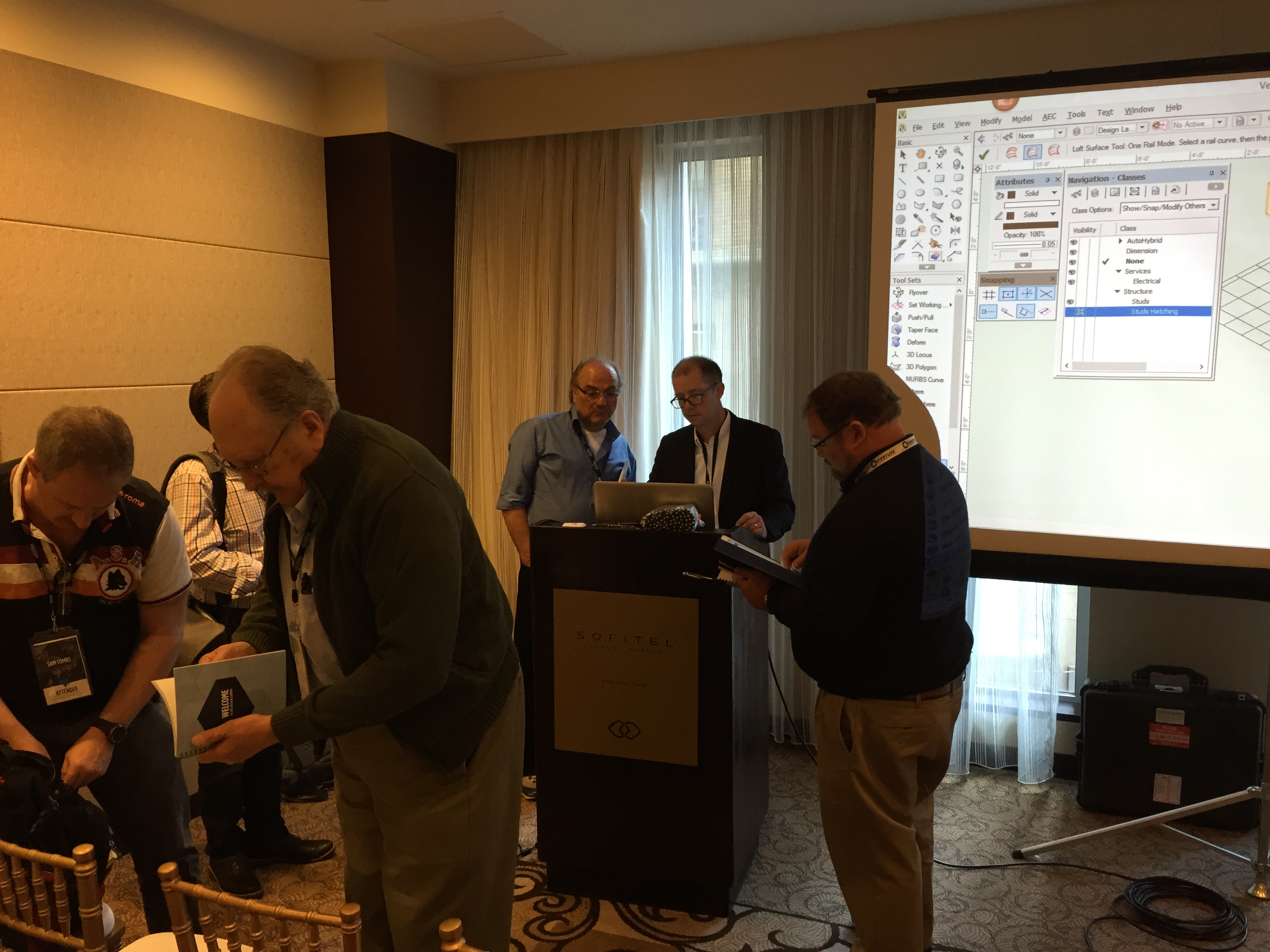-
Posts
3,958 -
Joined
-
Last visited
Content Type
Profiles
Forums
Events
Articles
Marionette
Store
Everything posted by Jonathan Pickup
-

difference between vectorworks and vectorworks architect?
Jonathan Pickup replied to bubbalauren's topic in Architecture
Robert Anderson has given a list of tool and additional functions, but it may not be clear what use they are: the connected walls mode is great, when you move one wall any walls that connect to it are stretched as well. the is a workaround to not having this, but this a still really useful. Site modeling, there is no work-around to not having site modelling. the site modelling allows you to create a 3D model of your site based on contours or other 3D points. from there you can check 3D recession planes of your project in relation to the boundary, solar animations... and so on the wall type library may not sound like much, but a properly set up wall type (setting the height, width and class of the wall) really makes it fast to draw. instead of having to remember what colour, line weight, fill, class and wall height you want to use for common wall types you can concentrate of the design. the issue manager is essential and makes filling in title blocks easier. you can specify which drawings you are going to issue and link this to the batch printing command. You can add issue notes only to the drawings that you are going to issue. i know that this is not a full list. For me, VectorWorks Architect is essential, i could work the way I do with out it. If you have a look at my demo version of my VectorWorks Architect Tutorial then you will get a ideal of the sort of things that the architect version has that the standard VectorWorks does not. -
select all the lines and arcs, then use the Compose command from the Tool menu
-
I use the call out tool a lot, mostly with the database option, but not always. The nice thing is that it takes the same time to type in a note as it does to add the note to the database. When it comes to making up a demolition plan I find the call out tool with the databse and the keynote option really useful. So often in projects you get repeating notes: ?Remove existing door for later re-use. Fome in opening and make good? that note can be stored in the database and used really quickly. Some notes are easier to type, but you can still use the call out tool for this. Ah, i almost forgot, you can set your preferences for the callout tool so that it always draws the same arrow, arrow size, angle, and you can control the line weight of the arrow head separate from the arrow line...
-

Naming Styles
Jonathan Pickup replied to LarryAZ's question in Wishlist - Feature and Content Requests
yes, what you need to do is to edit the list of classes that VectorWorks uses. The way to do this is to edit the plug-in object that you use to make the door. It?s posible but slightly complex. Then if you make any changes you will have to remake the correction if VectorWorks is reinstalled or updated. If you really want to do this I can give you more information. -
if you want to create an animation in 3D there is nothing that comes close to AnimationWorks. It is so cool. I helped on of my clients make a movie where you fly around the house.As you do so: the old roof lifs off the old internal walls slowly fade away the new walls appear the old deck and end of the building slide away the new end of the building slides in the newroof comes down the movie stops. To get all of this from inside VectorWorks is amazing.
-
if you are editing text use the Enter key on the far right hand side of the keyboard the exit the text before hitting the X key. Then the x key will work. Otherwise you can make a simple script that will get you back to the 2D selection tool. Create a new command and put this code in it: ---------------------- Procedure CustTool; BEGIN SetTool(-240); END; Run(CustTool); ---------------------- then you can add that command to the right mouse click... If you want more information on editing your workspace and how to add this to you right mouse then please refer to my VectorWorks Architect Tutorial Manual available from: https://vesta.safe-order.net/archoncad/manuals/manuals.php
-
i don?t like automatic set-up procedures. I don?t even like the create standard viewports... My belief is that it?s better to learn how to use layers and classes to organise your drawing information and how to use viewports to make your drawings. I think that you can draw efficiently with fewer layers than are suggested but the automatic drawing set up procedures. None of the automatic procedures yet has the ability to work out how many foundation details you need and whether these will fit in the drawing along with the foundation plan. Or another example; how many wall cladding details you need... but you still don?t want to start each project from scratch. What you can do is set up the structure of a typical small commercial project and save it as a template, so that for your purposes the job is set up automatically. Or open the last project that is similar to the one you are doing and Save As...
-

VW11-How to import multi-page PDF files
Jonathan Pickup replied to Kevin's topic in General Discussion
I use Adobe Acrobat Professional to do this. First create all the pages as outlined by Don and the others above. Then open the first page, page 1. Then using Arcobat Acrobat Professional, from the Menu bar choose Document > Pages > Insert then add all the pages one after the other. Professional gives you the ability to add links (linking a detail reference to the page with the detail), edit typos, and secure the document... -
there is a document perference for saving the viewport cache: Have you set this, and does this do what you want. Of course if you make changes to the model you will loose the viewport rendering.
-
to create my custom title block I used the A3 title block from the file that Robert told you about. Then I changed the font sizes and types, added logos, deleted parts that I don?t want, and generally mucked around with it until I was happy with it. you may not recognise it as being one of the ones that Robert guided you to: The I saved this in my library. I don?t use the create std. sheets command so it doesn?t matter too much where I save my title blocks. I also found that you can create pretty much any tile block you want, provided that you use the correct record format. If you don?t how to link text to record then this and how to make custom title blocks is covered in my Architect Tutorial manual.
-
you?re right when you say that VectorWorks should remember this page setting. I have just tried this on VectorWorks 11 and it works with a saved file. If you are talking about a new file nothaving the setting then you need to resave you default drawing. Set the page up the way that you want, then from the Menu Bar choose File > Save as Template... name the file to match the default; VectorWorks Default (for Macintosh) Default (for windows). If you have one of my manuals, this is covered at the back....
-
I wish there was a way to change all the sheet layers at the same time...
-
try setting the printer settings a sheet layer, rather than in the layer dialog box. The layer dialog box will only set the pariner size for that sheet. The next sheet layer you make should be the correct size.
-
when I first started using viewports I thought that i would usea combination of old and new methods. Not now, all I use is viewports to make drawings. You can draw anywhere and make drawings from what you?ve drawn. My advice is to use viewports. They are really useful, very fast and efficient....
-
possible and easy to do. If you don?t know how to make a template file; set up a drawing that suits you, import your hatches, then from the file menu choose Save As Template... on a Mac name the file VectorWorks Default on a PC name the file Default.sta This is covered in my Essential manual available from my website.
-
I think viewports are a huge leap forward when it comes to making details. If you looked at a section of a building, I would have a lot of detail already, so I can make a viewport of a portion of the section. This means that if I update the materials on the section the detail will update as well. The viewport annotation can use used to add notes and more detail... That way you don't have to have several layers for your details. I have covered this in my Essential Manual.
-
there is a camera tool available for use with VW. It comes from : http://www.ozcad.com.au and it is part of the Architect Australia/NZ package. if you need a 35mm camera lens equivalent then this will do it.
-
from the menu bar choose File > Print setup (Or page setup on a Mac). What are your settings here?
-
I always use winndoor manager but you don?t have to. You can use the standard window object as long as you choose the right settings: Then make this window into a symbol and then place the symbol into your your roof. you?re right about the glass, it?s a texture. You apply the glass texture to any shape... without questions the list doesn?t function
-
I had a client once that said about a self-trained staff menber: ?it?s a having a fool for a master? I?m a trainer and I belive that manuals can give DIY training direction, can teach you good habits and can, in some way, replace course for some people.
-
maybe I could help you if you contacted me directly. jon@archoncad.co.nz
-
Sorry to have upset you, I have no idea how much experience you have. My comments were meant in a nice way. I have many clients that still guess how many drawings are needed with out really working it out. What I?ve found is that if I work out the drawings, then I can figure out how to break up the drawings in to layers, classes and If I need, WGR.
-
i would tend to draw a lot in one layer and use classes to separate the objects. It?s not too late, you can still assign the tables to a furniture class and move them to the same layer as the walls.
-
one of the beauties of the wall type tool is that it does use the class and wall height. I use the wall type tool to draw foundation walls, cavity walls, timber walls, partition walls... all of these are drawn on the same layer but on different classes, and they have dfferent heights.
-
layer link sure does sort this out. It?s not easy say in words, but basically you WGR the file you want. This gives you a new layer in the file, and this new layer should be Layer linked to a working layer where you can do the work.


